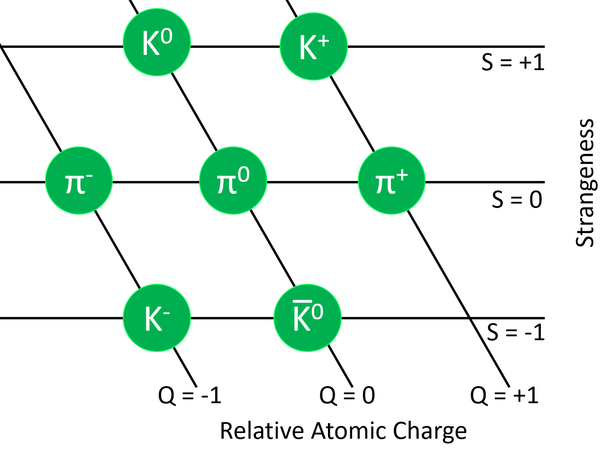Difference between revisions of "Meson"
(Created page with "==Key Stage 5== ===Meaning=== '''Mesons''' are a type of hadron consisting of a quark-antiquark pair. ===About Mesons=== : '''Mesons''' have a very short Half L...") |
(→Examples) |
||
| Line 29: | Line 29: | ||
| style="height:20px; width:200px; text-align:center;"|[[Electrical Charge|'''Charge''']] | | style="height:20px; width:200px; text-align:center;"|[[Electrical Charge|'''Charge''']] | ||
| style="height:20px; width:200px; text-align:center;"|'''[[Strangeness]]''' | | style="height:20px; width:200px; text-align:center;"|'''[[Strangeness]]''' | ||
| − | |||
| − | |||
| − | |||
| − | |||
| − | |||
| − | |||
| − | |||
| − | |||
| − | |||
| − | |||
| − | |||
| − | |||
| − | |||
| − | |||
|- | |- | ||
| style="height:20px; width:200px; text-align:center;"| | | style="height:20px; width:200px; text-align:center;"| | ||
| Line 70: | Line 56: | ||
| style="height:20px; width:200px; text-align:center;"|<math>S=0</math> | | style="height:20px; width:200px; text-align:center;"|<math>S=0</math> | ||
| + | |- | ||
| + | | style="height:20px; width:200px; text-align:center;"| | ||
| + | [[Strange-quark]] | ||
| + | | style="height:20px; width:200px; text-align:center;"|<math>q=-\frac{1}{3}</math> | ||
| + | |||
| + | | style="height:20px; width:200px; text-align:center;"|<math>S=-1</math> | ||
| + | |||
| + | |- | ||
| + | | style="height:20px; width:200px; text-align:center;"| | ||
| + | [[Antistrange-quark]] | ||
| + | | style="height:20px; width:200px; text-align:center;"|<math>q=+\frac{1}{3}</math> | ||
| + | |||
| + | | style="height:20px; width:200px; text-align:center;"|<math>S=+1</math> | ||
|} | |} | ||
Revision as of 14:24, 18 July 2019
Contents
Key Stage 5
Meaning
Mesons are a type of hadron consisting of a quark-antiquark pair.
About Mesons
- Mesons have a very short half life, decaying via the weak nuclear interaction or though the quark-antiquark pair annihilating one another.
- Mesons consisting of the quarks; up-quark, down-quark and strange-quark are divided into two main categories; π-mesons and k-mesonss.
- K-mesons have a strangeness of +1 or -1. However, π-mesons do not carry strangeness.
- Mesons are affected by the:
Determining Meson Composition
NB: You do not need to memorise the exact composition of a given meson. However, you should be able to determine the quark composition given the charge and strangeness of the meson and by remembering the properties of the up-quark, down-quark and strange-quark.
- Mesons can be shown in the following diagram:
| The composition of these mesons can be determined given their charge and strangeness. |
Examples
| Quark | Charge | Strangeness |
| \(q=+\frac{2}{3}\) | \(S=0\) | |
| \(q=-\frac{2}{3}\) | \(S=0\) | |
| \(q=-\frac{1}{3}\) | \(S=0\) | |
| \(q=+\frac{1}{3}\) | \(S=0\) | |
| \(q=-\frac{1}{3}\) | \(S=-1\) | |
| \(q=+\frac{1}{3}\) | \(S=+1\) |
| Determine the composition of the π+ | Determine the composition of the K- |
|
π+ has a strangeness of 0, therefore it contains no strange-quark or antistrange-quark. π+ has a positive charge. This can be achieved with one charge of \(+\frac{2}{3}\) (an up-quark) and \(+\frac{1}{3}\) (an antidown-quark). Therefore \(π^+ = u + \bar{d}\) An up-antidown pair. |
K- has a strangeness of -1, therefore it contains a strange-quark. K- has a negative charge. This can be achieved with one its strange-quark with an charge of [[\(-\frac{1}{3}\) and another charge of \(-\frac{2}{3}\) (an antiup-quark). Therefore \(K^- = S + \bar{u}\) A strange-antiup pair. |
